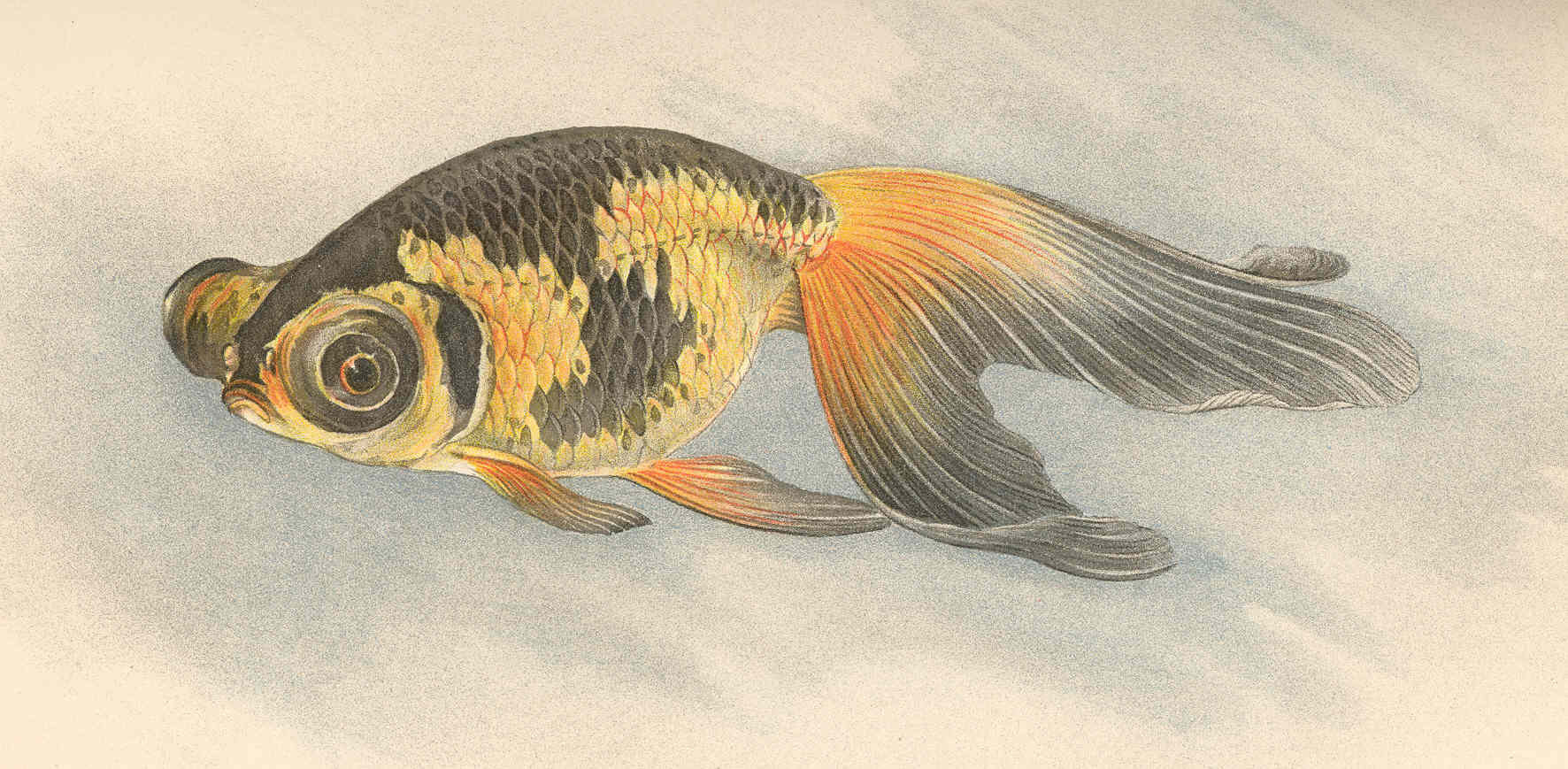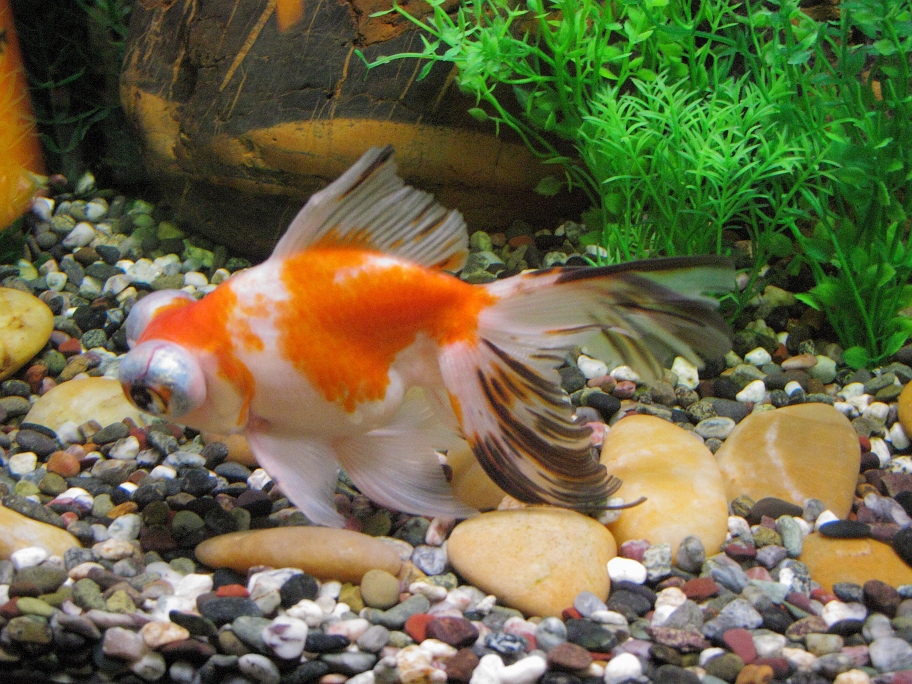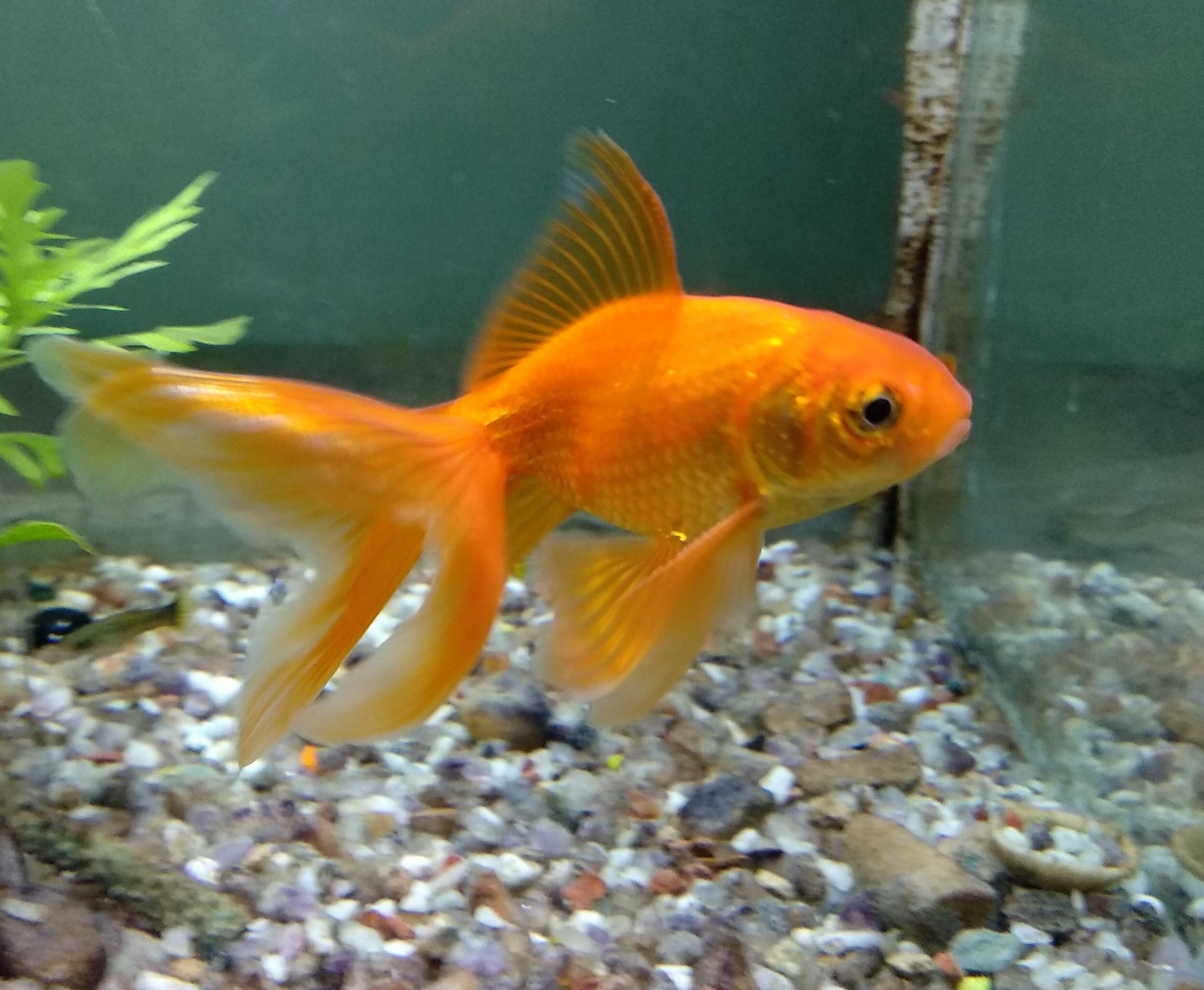|
Calico (goldfish)
Calico goldfish are goldfish of any breed that have a type of scale that is intermediate between the metallic type of scales and the transparent type. These scales have a slight sheen that produces a pearly appearance."An Interpet Guide to Fancy Goldfish" by Dr. Chris Andrews, Interpet Publishing, 2002 - "Fancy Goldfish: A Complete Guide to Care and Collecting" by Dr. Erik L. Johnson, D.V.M. and Richard E. Hess, Weatherhill, Shambala Publications, Inc., 2006 - The name "calico goldfish" came about because the first fish that were introduced with this type of scales had a mottled calico pattern with several colours. Calico goldfish often have patches of red, yellow, grey and black along with dark speckles on a blue background. This coloration usually extends over the fins. Although calico coloration occurs in many fancy goldfish varieties such as telescope eyes, fantails, ryukins, orandas, and ranchus, the nacreous scale characteristic is usually exclusive to the shubunkins ... [...More Info...] [...Related Items...] OR: [Wikipedia] [Google] [Baidu] |
Goldfish
The goldfish (''Carassius auratus'') is a freshwater fish in the family Cyprinidae of order Cypriniformes. It is commonly kept as a pet in indoor aquariums, and is one of the most popular aquarium fish. Goldfish released into the wild have become an invasive pest in parts of North America. Native to East Asia, the goldfish is a relatively small member of the carp family (which also includes the Prussian carp and the crucian carp). It was first selectively bred for color in imperial China more than 1,000 years ago, and several distinct breeds have since been developed. Goldfish breeds vary greatly in size, body shape, fin configuration, and coloration (various combinations of white, yellow, orange, red, brown, and black are known). History Various species of carp (collectively known as Asian carp) have been bred and reared as food fish for thousands of years in East Asia. Some of these normally gray or silver species have a tendency to produce red, orange or yellow ... [...More Info...] [...Related Items...] OR: [Wikipedia] [Google] [Baidu] |
Calico
Calico (; in British usage since 1505) is a heavy plain-woven textile made from unbleached, and often not fully processed, cotton. It may also contain unseparated husk parts. The fabric is far coarser than muslin, but less coarse and thick than canvas or denim. However, it is still very cheap owing to its unfinished and undyed appearance. The fabric was originally from the city of Calicut in southwestern India. It was made by the traditional weavers called cāliyans. The raw fabric was dyed and printed in bright hues, and calico prints became popular in Europe. History Origins Calico originated in Calicut, from which the name of the textile came, in South India, now Kerala, during the 11th century, where the cloth was known as "chaliyan". It was mentioned in Indian literature by the 12th century when the polymath and writer Hemachandra described calico fabric prints with a lotus design.''Encyclopædia Britannica'' (2008)"calico" Calico was woven using Gujarati cotton from Su ... [...More Info...] [...Related Items...] OR: [Wikipedia] [Google] [Baidu] |
Telescope Eye
The telescope eye () is a goldfish characterised by its protruding eyes.Andrews, Chris. An Interpet Guide to Fancy Goldfish, Interpet Publishing, 2002. - Johnson, Dr. Erik L., D.V.M. and Richard E. Hess. Fancy Goldfish: A Complete Guide to Care and Collecting, Weatherhill, Shambala Publications, Inc., 2006. - Bristol Aquarists' Society, Bristol Aquarists.org, United Kingdom retrieved on: 4 June 2007 It was first developed in the early 1700s in China, where the trait was referred to as dragon eyes. Description  Except for its enlarged projecting e ...
Except for its enlarged projecting e ...
[...More Info...] [...Related Items...] OR: [Wikipedia] [Google] [Baidu] |
Fantail (goldfish)
The Fantail is a goldfish that possesses an egg-shaped body, a high dorsal fin, a long quadruple caudal fin, and no shoulder hump."Fancy Goldfish: A Complete Guide to Care and Collecting" by Dr. Erik L. Johnson, D.V.M. and Richard E. Hess, Weatherhill, Shambala Publications, Inc., 2006. – "An Interpet Guide to Fancy Goldfish" by Dr. Chris Andrews, Interpet Publishing, 2002. - It is similar to the Ryukin, and is relatively common in western countries. Description The Fantail goldfish may have either metallic or nacreous scales and normal or telescope eyes. Telescope eyes do not develop until the fish is 6 months old. Its fins are less developed than the Ryukin. It supports double anal and tail fins. The anal and caudal fins are well divided into two matching halves. Although generally considered a hardy goldfish, Fantails can be sensitive to prolonged exposure to low water temperatures. Keeping Fantails in an aquarium requires an ideal temperature of 73 to 74 degrees ... [...More Info...] [...Related Items...] OR: [Wikipedia] [Google] [Baidu] |
Ryukin
The is a short deep-bodied fancy goldfish with a characteristic hump in the shoulder region.Andrews, Chris, Dr. An Interpet Guide to Fancy Goldfish, Interpet Publishing, 2002. - Johnson, Erik L., Dr. D.V.M. and Richard E. Hess. Fancy Goldfish: A Complete Guide to Care and Collecting, Weatherhill, Shambala Publications, Inc., 2006. - Description The ryukin is a hardy and attractive variety of goldfish with a pointed head and has a pronounced hump on the back behind the head. It may be long-finned or short-finned with either a triple or quadruple tail. The dorsal fin is high while the caudal fin is often twice as long as the body. The caudal fin may also have three or four lobes. Ryukins come in deep-red, red-and-white, white, silver, blue, black, orange, lavender grey, iron and calico coloration. The ryukin is a fine aquarium fish that can reach up to 8 inches (21 centimeters) in length. Some ryukins are reported to grow up to 10 inches in large aquariums and commercial ponds. ... [...More Info...] [...Related Items...] OR: [Wikipedia] [Google] [Baidu] |
Oranda
An oranda is a breed of goldfish characterized by a prominent bubble-like "hood" on the head. The headgrowth or hood (also known as ''wen'' or ''crown'') may be a prominent growth on the top of the head (cranial region) or may encase the entire face except the mouth.Andrews, Chris. An Interpet Guide to Fancy Goldfish, Interpet Publishing, 2002. - Johnson, Dr. Erik L., D.V.M. and Richard E. Hess. Fancy Goldfish: A Complete Guide to Care and Collecting, Weatherhill, Shambala Publications, Inc., 2006. - When it was first imported from China to Japan it was mistakenly thought to be native to the Netherlands, and was therefore dubbed the "Holland Lionmask", "Dutch Lionhead", and "Netherlands Lion Head" ( ja, オランダ獅子頭, oranda shishigashira), from which its English name "oranda" derives. Description Due to the fleshy outgrowth on the upper half of its head and sides of its face, the oranda has become one of the most popular goldfish. The headgrowth is described as a " ... [...More Info...] [...Related Items...] OR: [Wikipedia] [Google] [Baidu] |
Ranchu
The (also Maruko) is a hooded variety of goldfish native to China.Andrews, Dr. Chris. "An Interpet Guide to Fancy Goldfish", Interpet Publishing, 2002. - It is referred to as the 'king of goldfish" by the Japanese. Maruko more commonly refers to the egg-fish goldfish. Species origins and evolution The Ranchu is a member of the Japanese development of the lionhead. They are the direct outcome of crossbreeding experiments with Chinese lionhead specimens. Image:Ranchu.JPG, Orange Ranchu Goldfish. Image:Black Ranchu.jpg, Black Ranchu Goldfish. Image:Blue Ranchu.jpg, Blue Ranchu Goldfish. Morphology Ranchus have egg-shaped bodies and deep bellies – between 5/8 to 3/4 the length of the fish. These goldfish have no dorsal fin. Breeding standards require that the back should not have any vestiges of the dorsal fin on it. The back should be rounded, not flat like a lion head. The area of the caudal peduncle should curve sharply downwards to meet the tail. The caudal peduncle it ... [...More Info...] [...Related Items...] OR: [Wikipedia] [Google] [Baidu] |
Shubunkin
are a hardy, single-tailed goldfish with nacreous scales and a pattern known as calico. The Shubunkins are of Japanese origin.Chris Andrews, Interpet Publishing (2002) ''An Interpet Guide to Fancy Goldfish''. Erik L. Johnson, D.V.M. and Richard E. Hess (2006) ''Fancy Goldfish: A Complete Guide to Care and Collecting'', Weatherhill, Shambala Publications, Inc. The Shubunkin was created by Yoshigoro Akiyama ( :ja:秋山吉五郎) by crossing Calico telescope eye with a Comet goldfish and a Common goldfish. Description Shubunkins are similar to the common goldfish and comet goldfish in appearance. They were first bred in Japan, from crossbreeding the calico telescope eye goldfish (Demekins), comet goldfish, and the common goldfish ''c.'' 1900. They have streamlined bodies with well-developed and even fins. However, the Shubunkins are calico goldfish; they possess nacreous scales (an intermediate between metallic and transparent scales that are pearly in appearance). The overla ... [...More Info...] [...Related Items...] OR: [Wikipedia] [Google] [Baidu] |
Common Goldfish
The common goldfish is a breed of goldfish with no other differences from its living ancestor, other than its color and shape. Goldfish are a form of domesticated wild carp and are a close relative of koi. Most varieties of fancy goldfish were derived from this simple breed. Common goldfish come in a variety of colors including red, orange, red/white, white/black, yellow/white, blue, grey/brown/, olive green, yellow, white, and black, with the most common variation being orange, hence the name. Sometimes, the brightness, duration, and vividness of the color may be an indication of the fish's health status, but not always , as manifold waters conditions facilitate the apparent discoloration. Temperament Common goldfish are social animals who prefer living in groups. They are able to coexist with any fish , providing they're tame and sociable. With the provision of general care and attention, common goldfish can become tame. Once familiar with the face of its owner, swimming ... [...More Info...] [...Related Items...] OR: [Wikipedia] [Google] [Baidu] |
.jpg)



.jpg)

